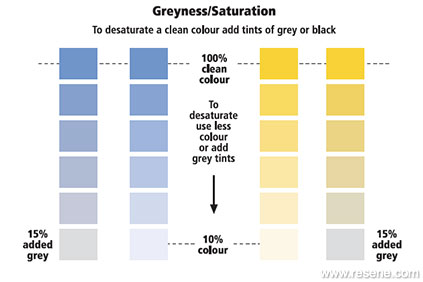As of 2006, old Resene Total Colour codes, such as 1 R020, were replaced with a new code format that enables easier comparison between colours.
The new codes have been designed to translate into colour information enabling specifiers and decorators to make direct comparisons on three attributes between multiple colours. While the old codes allowed comparison of colours on scales of dark and light and position within general colourspace, there was no provision for a measurement of the greyness of a colour.
The Resene Total Colour System codes follow a format of B63-084-258.
The first letter or letters tells you what colour group the colour is from:
| B = Blue | BR = Brown | G = Green |
| M = Metallics | N = Neutral | O = Orange |
| R = Red | V = Violet | Y = Yellow |
The first digits denote the colour's luminance, with O being approximately black and 100 being approximately white.
The second set of digits denotes the saturation of the colour or how far from grey the colour is. That is, the lower the number the more grey in the colour, the higher the number the cleaner the colour is. For example, Resene Black (black) has a value of 000 while Resene Turbo Y84-198-087 (bright yellow) has a value of 198.
The last set of digits tells you where the colour sits on a wheel of colour of 0 to 360 degrees. This allows you to place multiple colours into a sequence and determine the relative positioning of colours.
By comparing multiple colours using the new colour codes you can establish whether a colour is greyer or cleaner, brighter or darker and where they sit on a colour wheel.
| R | (Red) | = | 357-39 inclusive |
| O | (Orange) | = | 40-69 inclusive |
| Y | (Yellow) | = | 70-90 inclusive |
| G | (Green) | = | 91-204 inclusive |
| B | (Blue) | = | 205-284 inclusive |
| V | (Violet) | = | 285-356 inclusive |
| N | (Neutral) | = | Saturation of 0-8 |
| BR | (Brown) | = | Luminance of 0-39, saturation of 4-10 or luminance of 40-80, saturation of 4-25 |
| M | (Metallic) | = | Colours derived from metallic tones |
Luminance is a brightness measure and describes the amount of light that is reflected from a flat, painted surface. Luminance is an indicator of how bright the paint will appear.
Luminance decreases when adding grey or black paint to either a pure colour or lighter hues of a colour.


Saturation means purity and refers to the intensity of a specific hue (colour). It is based on the colour's purity; a highly saturated hue has a vivid, intense colour, while a less saturated hue appears more muted and grey. With no saturation at all, the hue becomes a shade of grey.
The purest colour is achieved by using clean undiluted colour. If the intensity drops the saturation also drops.
To desaturate a colour in a paint system you can add tints of white, grey, black or the hue's complementary (opposite) colour.
The new codes will start to come through as colour charts are reprinted, though it will be some time before all charts incorporate the new codes.
